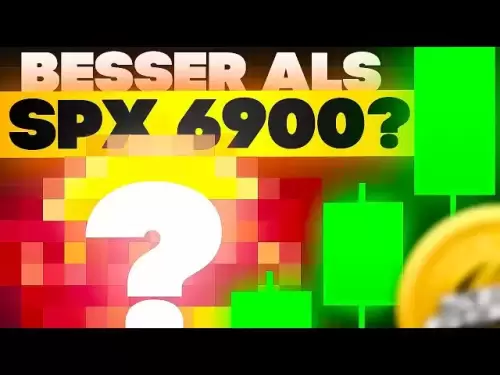-
 Bitcoin
Bitcoin $110,957.0809
1.97% -
 Ethereum
Ethereum $2,735.7206
4.87% -
 Tether USDt
Tether USDt $1.0002
0.00% -
 XRP
XRP $2.3924
3.71% -
 BNB
BNB $668.8382
1.31% -
 Solana
Solana $156.4586
3.66% -
 USDC
USDC $1.0000
-0.01% -
 TRON
TRON $0.2901
0.93% -
 Dogecoin
Dogecoin $0.1819
6.79% -
 Cardano
Cardano $0.6192
5.41% -
 Hyperliquid
Hyperliquid $40.4637
4.42% -
 Sui
Sui $3.0207
4.29% -
 Bitcoin Cash
Bitcoin Cash $507.8258
1.72% -
 Chainlink
Chainlink $14.1774
2.42% -
 Stellar
Stellar $0.2867
11.94% -
 UNUS SED LEO
UNUS SED LEO $9.0125
-0.63% -
 Avalanche
Avalanche $19.2747
5.23% -
 Shiba Inu
Shiba Inu $0.0...01244
5.05% -
 Hedera
Hedera $0.1704
6.24% -
 Toncoin
Toncoin $2.8382
1.37% -
 Litecoin
Litecoin $90.4014
3.56% -
 Monero
Monero $322.4151
3.33% -
 Polkadot
Polkadot $3.6133
4.86% -
 Dai
Dai $1.0000
-0.01% -
 Ethena USDe
Ethena USDe $1.0010
0.06% -
 Uniswap
Uniswap $8.3323
8.60% -
 Bitget Token
Bitget Token $4.3790
1.31% -
 Pepe
Pepe $0.0...01087
6.88% -
 Aave
Aave $297.1808
2.13% -
 Pi
Pi $0.4688
2.23%
How to use the Volume Profile indicator for Bitcoin trading?
2025/07/09 06:08

Understanding the Volume Profile Indicator
The Volume Profile is a powerful analytical tool used in cryptocurrency trading to visualize where the majority of trading volume has occurred at specific price levels. Unlike traditional volume indicators that display volume over time, the Volume Profile shows how much volume was traded at different price points during a specified period. For Bitcoin traders, this insight can be crucial in identifying key support and resistance zones, determining fair value, and making informed decisions.
Volume Profile helps traders see where most buying or selling pressure occurred.
In Bitcoin markets, which are highly volatile and often influenced by large institutional players, understanding where clusters of volume exist can provide an edge. These clusters indicate areas where significant trading activity took place and may act as future zones of interest for price action.
Setting Up the Volume Profile on Trading Platforms
Most modern trading platforms such as TradingView, ThinkorSwim, and MetaTrader 4/5 offer Volume Profile tools, although they may not always be enabled by default. Here's how to activate it:
- Open your preferred charting platform and load a Bitcoin chart (e.g., BTC/USD).
- Navigate to the "Indicators" section and search for "Volume Profile."
- Select the indicator and apply it to the chart.
- Adjust settings such as time range (e.g., previous day, week, or session) and price intervals if needed.
Ensure the Volume Profile aligns with your trading timeframe, whether intraday, daily, or weekly.
Some platforms allow customization of the profile based on fixed ranges or variable time periods. Traders should experiment with these options to find what works best for their strategy.
Interpreting Volume Profile Levels
Once applied, the Volume Profile will typically appear on the side of the chart, showing horizontal bars that represent volume at each price level. The longest bar indicates the Point of Control (POC), which is the price level with the highest traded volume.
- The POC acts as a potential equilibrium or fair value area.
- Other notable levels include Value Areas (VA), which encompass approximately 70% of total volume.
- Levels outside the VA are considered imbalances and may signal strong support or resistance zones.
Traders use POC and VA to assess whether Bitcoin is overextended relative to its recent volume distribution.
For example, if Bitcoin trades significantly above the VA, it may suggest overbought conditions, while a move below the VA could indicate oversold territory. These insights help traders anticipate potential reversals or continuations.
Using Volume Profile for Entry and Exit Points
Incorporating the Volume Profile into a Bitcoin trading strategy involves analyzing how price interacts with key volume levels. Here’s how traders can identify entries and exits:
- Watch for price to return to the POC after a breakout — this could present a retest opportunity.
- If Bitcoin breaks above the VA and maintains momentum, consider entering long positions with targets beyond the VA.
- Conversely, a breakdown below the VA might signal a shorting opportunity with stop-loss placed just below the new support level.
- Use the Volume Profile in conjunction with other tools like moving averages or RSI to confirm signals.
Successful traders combine Volume Profile with price action and other technical indicators to filter false signals.
It's essential to monitor how volume behaves when price revisits previously established high-volume zones. A lack of participation during a revisit may indicate weakening interest, potentially signaling a reversal.
Managing Risk with Volume Profile Insights
Risk management is critical in Bitcoin trading due to its inherent volatility. Volume Profile aids in setting more precise stop-loss and take-profit levels by highlighting historically significant price zones.
- Place stop-loss orders slightly beyond low-volume regions to avoid being stopped out prematurely.
- Set profit targets near high-volume areas where price is likely to stall or reverse.
- Monitor changes in the POC and VA over time to adjust risk parameters accordingly.
Effective risk control using Volume Profile helps preserve capital during sudden market swings.
Traders should also pay attention to shifts in the POC. If the Point of Control moves consistently higher or lower, it may indicate a change in trend direction, requiring adjustments to existing positions.
Frequently Asked Questions
1. Can I use the Volume Profile on all Bitcoin exchanges?
While the Volume Profile is available on most charting platforms, some exchanges may not integrate advanced technical tools directly. However, you can still analyze Bitcoin price data from supported platforms even if you trade on an exchange without native Volume Profile support.
2. Is the Volume Profile reliable during low-liquidity periods?
During low-liquidity phases, especially in certain altcoin markets, the Volume Profile may produce misleading signals. In Bitcoin trading, liquidity tends to remain relatively high, but traders should still cross-check with other indicators during thin markets.
3. How often should I update my Volume Profile settings?
The optimal frequency depends on your trading style. Day traders may reset the Volume Profile every session, while swing traders might prefer daily or weekly resets to capture broader volume dynamics.
4. Does the Volume Profile work well with leveraged trading?
Yes, but caution is advised. Using Volume Profile to identify high-probability setups can enhance leveraged trades, yet leverage amplifies both gains and losses. Always ensure proper position sizing and risk limits are in place.
免責事項:info@kdj.com
提供される情報は取引に関するアドバイスではありません。 kdj.com は、この記事で提供される情報に基づいて行われた投資に対して一切の責任を負いません。暗号通貨は変動性が高いため、十分な調査を行った上で慎重に投資することを強くお勧めします。
このウェブサイトで使用されているコンテンツが著作権を侵害していると思われる場合は、直ちに当社 (info@kdj.com) までご連絡ください。速やかに削除させていただきます。
- Nexbridge、Nexplace、およびBitcoinエコシステム:新しい金融フロンティアの構築
- 2025-07-09 23:10:13
- MEXC LaunchPad&Pump Token:40%の割引をつかみますか?
- 2025-07-09 22:50:12
- 貿易システム革命:XDCとファックスの終わりがどのように再構築されているか
- 2025-07-09 23:10:13
- Ripple、Clarity Act、およびXRPケース:暗号規制に関するニューヨークの分
- 2025-07-09 23:50:12
- Rs 50コインはありませんか?デリーHCは、インドが紙幣を好む理由を聞いています
- 2025-07-09 23:15:11
- Rs 50コインはありませんか?デリーHCは、紙幣が最高に君臨する理由を聞いています
- 2025-07-09 23:50:12
関連知識

How to trade Dogecoin based on funding rates and open interest
2025-07-07 02:49:34
<h3>Understanding Funding Rates in Dogecoin Trading</h3><p>Funding rates are periodic payments made to either long or short traders ...

What is the 'God Mode' indicator for Dogecoin
2025-07-07 16:42:48
<h3>Understanding the 'God Mode' Indicator</h3><p>The 'God Mode' indicator is a term that has emerged within cryptocurrency trading ...

Using Gann Fans on the Dogecoin price chart
2025-07-07 21:43:10
<h3>Understanding Gann Fans and Their Relevance in Cryptocurrency Trading</h3><p>Gann Fans are a technical analysis tool developed b...

How to spot manipulation on the Dogecoin chart
2025-07-06 12:35:49
<h3>Understanding the Basics of Chart Manipulation</h3><p>Chart manipulation in the cryptocurrency space, particularly with Dogecoin...

Dogecoin market structure break explained
2025-07-07 02:51:32
<h3>Understanding the Dogecoin Market Structure</h3><p>Dogecoin, initially created as a meme-based cryptocurrency, has evolved into ...

How to backtest a Dogecoin moving average strategy
2025-07-08 04:50:05
<h3>What is a Moving Average Strategy in Cryptocurrency Trading?</h3><p>A moving average strategy is one of the most commonly used t...

How to trade Dogecoin based on funding rates and open interest
2025-07-07 02:49:34
<h3>Understanding Funding Rates in Dogecoin Trading</h3><p>Funding rates are periodic payments made to either long or short traders ...

What is the 'God Mode' indicator for Dogecoin
2025-07-07 16:42:48
<h3>Understanding the 'God Mode' Indicator</h3><p>The 'God Mode' indicator is a term that has emerged within cryptocurrency trading ...

Using Gann Fans on the Dogecoin price chart
2025-07-07 21:43:10
<h3>Understanding Gann Fans and Their Relevance in Cryptocurrency Trading</h3><p>Gann Fans are a technical analysis tool developed b...

How to spot manipulation on the Dogecoin chart
2025-07-06 12:35:49
<h3>Understanding the Basics of Chart Manipulation</h3><p>Chart manipulation in the cryptocurrency space, particularly with Dogecoin...

Dogecoin market structure break explained
2025-07-07 02:51:32
<h3>Understanding the Dogecoin Market Structure</h3><p>Dogecoin, initially created as a meme-based cryptocurrency, has evolved into ...

How to backtest a Dogecoin moving average strategy
2025-07-08 04:50:05
<h3>What is a Moving Average Strategy in Cryptocurrency Trading?</h3><p>A moving average strategy is one of the most commonly used t...
すべての記事を見る

























































































